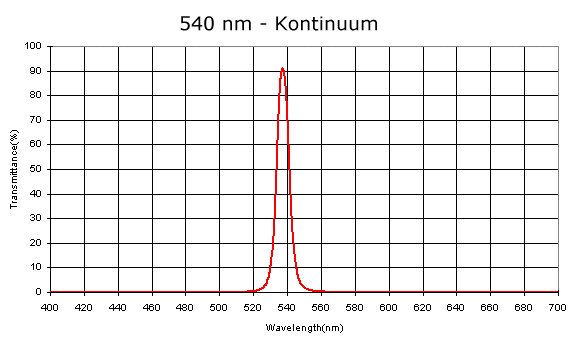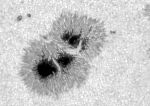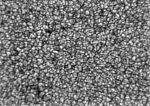Distribution
![]() News
News
![]() Notes & Interesting Articles
Notes & Interesting Articles
![]() Overview
Overview
![]() Pricing
Pricing
![]() Products
Products
Accessories and Options
![]() Filters
Filters
![]()

Baader Planetarium Solar Continuum Filter

Right: Baader 2 inch Solar Continuum filter with provided plastic case. Also available in 1.25 inch diameter (78,041 bytes).
Click on image for enlarged view (135,009 bytes).
When used as directed as a secondary in line filter, then the Solar Continuum filter cuts out all remaining light from the solar spectrum but that limited narrow spectral region around 540 nm. When observing at this wavelength then the granulation and the structure of the sunspots are revealed with the highest contrast.
This filter is incompatible with any other filter that does not pass the green wavelengths including Hydrogen-Alpha filters such as the DayStar models which we also offer.
-
Filters take away but they can not add - diminishing some parts of the spectrum
so that we might see what is otherwise obscured...
How Are These Constructed?
The filter is made with a disc of transparent optical glass that has been ground to be plane parallel and then polished until very smooth. The glass undergoes a vacuum deposition coating process where numerous micron-thin coatings of various elements are applied one upon another in a precise order and thicknesses. The coatings are calculated to transmit desired wavelengths (portions of the visible spectrum), while simultaneously rejecting other wavelengths.
When tilted while exposed to bright light then both the filter surfaces will appear like a silvered mirror. And when tilted it will present with greenish undertone around the perimeter of the female side, and a magenta around the perimeter of the male side. When viewed with no backlighting and parallel to the eye from either side, then the filter element appears to impart a bright green cast, if the filter tilted to a steeper angle this changes from green to violet tones, and as the tilting advances it will ultimately show blue and then magenta tones.
The filter element is housed in a machined aluminum cell, and held in place by a thread-in retaining ring. The filter name, size and part number are in silver, and this mirror like print when combined with the small print size make this information difficult to read under dim red lighting. Company Seven recommends our customers keep these filters in well organized accessory cases, so that you know which filter is which. It helps to become familiar with how the elements appear too (read descriptions below).
The Baader Solar Continuum filter is made available in diameters of 1.25 (31.7 mm) or 2 inch (50.8 mm) so that it can be installed in line onto many accessories, or directly onto most popular eyepieces.
What Does This Do For Me?
With the Baader Continuum Filter provides better views of solar detail than using the white light filters alone. The sunspots, faculae, and granulation appear more distinct - with better contrast. While most amateurs expect to see their expected view of the Sun in deep red, most observers commend that the green image is pleasing to the eyes - and in fact this is very close to the area of the spectrum where the human eye is most sensitive. Most observers find the added contrast (discrimination between light and dark features) is better with the green, than with filters that show the sun as a whitish disc.
For digital or film imaging, the results will depend on the sensitivity of the system.
Of course all of this is dependent on having a suitable aperture high resolution telescope, ideally 4 inch (102 mm) or larger aperture refractors will do well. An achromatic refractor can perform well for this use since any residual chromatism of the lens becomes irrelevant while one is really only focusing one area of the spectrum.
 Right: Baader Solar Continuum filter transmission curves (134,597 bytes).
Right: Baader Solar Continuum filter transmission curves (134,597 bytes).
Features Of The Baader Filters:
Examples of Imaging with the Solar Continuum Filter:
Consider the following three picture which were taken by Mr. Oliver Grattepanche. He explains the instrument and accessories employed: "TSC 225 Schmidt Cassegrain from TAKAHASHI, NJP160 mount, F/40 with 2X Big Barlow TeleVue, NGFs more focuser, and OF course your incredible Baader astro+solarly filter D:3.8, IR CUT filter and Continuum filter".



Above Left to Right: Sunspot taken with VestaPro with 1/3 inch diagonal black and white CCD sensor,
Surface granulation shown with 800 CCD frames stacked with IRIS astronomical images processing software.
The colors were added afterward basic image compiling and processing for aesthetic purposes.
Click on images to see enlarged view
The optional wood case is foam lined with cutaway spaces for filters, eyepieces and other small accessories for your telescope. Please refer to our price list for current prices for the filter set and the optional case or contact Company Seven for more information.
Right: optional wood box for Color Filter Set (52,803 bytes)
Click on the image to see enlarged view (190,049 bytes).
FURTHER READING
- It is best to protect the filter from sharp edges or any item that could cause a scratch or abrade the glass.
- When not in use, store the filter in a its provided rigid container, and it may help you to keep them organized in a fitted carrying case.
- Dew may form on the filters, if this happens do not store a wet filter into its airtight container for long periods of time; whenever possible let the filter "dry out" in order to reduce the potential for problems developing associated with Fungus, etc.
- Draw any large, loose bits of foreign matter from the surface of the glass with an air bulb or small vacuum. Stubborn particles can be removed with a soft camel's hair brush. Throughout the year, but especially in cold climates when static become more of a problem we particularly recommend the use of a Staticmaster brush.
- Place a few drops of an approved lens cleaning solution (by Carl Zeiss or Kodak) or mild soap solution of clear dish washing liquid diluted with distilled water onto a cotton swab. Then gently wipe in a circular motion with little or no pressure. The filter can be damaged if there are tiny abrasive particles on the surface which are pressed in by rubbing hard.
Contents Copyright 1999-2006 Company Seven All Rights Reserved

